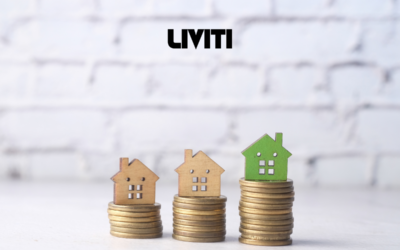The Australian Property market is witnessing a significant shift in its home values, by reverting back up from the short downtrend. According to the CoreLogic Home Value Index (HVI) April 2025 report, home values increased 0.4% in March 2025, demonstrating the Australian real estate market regained resiliency despite being in the downtrend.
After a brief decline, this upward trend suggests a possible turning moment for both investors and purchasers. This could be a pivotal time for individuals wishing to enter or grow in the market, since rental yields are at their highest level since 2019 and home values are starting to rise again.
In today’s competitive real estate market, knowing these patterns will help you make wise decisions whether you’re a seller, investor, or first-time home buyer. After the meeting held on 1st April, 2025, the Board of the RBA declared that the cash rate would remain unchanged at 4.10%.
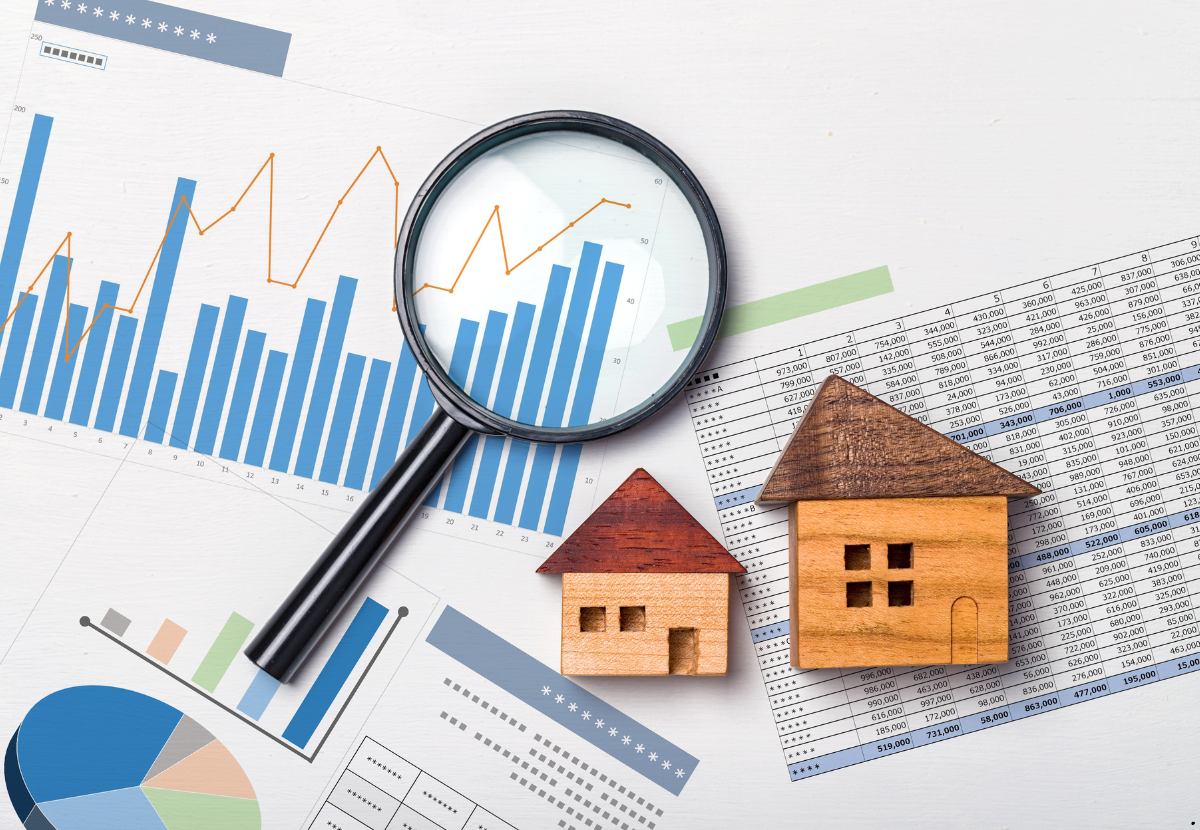
Key Property Market Trends & Performance on March 2025
Making wise property investment decision requires an understanding of current market trends. Below is a summary of the key findings from CoreLogic March 2025 Home value Index report:
- Reversing the recent dip and indicating renewed demand, home values rose by 0.4%.
- Although the difference is closing, regional real estate markets (+0.5%) still outperformed capital cities (+0.4%).
- The reversal of the previous decline points to a resurgence of confidence in the housing market, which was aided by stable economic conditions. Demand is expected to continue growing even though the cash rate remains unchanged. Even though there was a decrease, it still provides consistency with no increase for a while which can reassure potential investors.
- The reversal in the declining shift proves that the buyer sentiment was positively impacted by the cash rate cut in February. RBA’s decision to not change the current cash rate will support price growth as a stable cash rate provides stability.
Capital City Performance in Australian Property Market 2025
- Sydney: Home values increased by 0.3% in March, factoring to a 0.4% rise over the quarter and an annual growth of 0.9%. The median dwelling value stands at $1,190,616 as of 31st March, 2025.
- Melbourne: Dwelling values saw a rise of 0.5% in March, with a 0.3% quarterly rise. However, the annual change remains negative at -2.6%, with the median dwelling value of $781,318.
- Brisbane: The city saw a rise of 0.4% in March, a 0.9% rise over the quarter, and a solid 8.6% annual growth, bringing the median dwelling value to $899,824.
- Adelaide: Second on the leader board, Adelaide recorded a 0.8% rise in March, and 1.0% quarterly increase, and an impressive 11.0% annual growth, with the median dwelling value of $827,675.
- Perth: Home values increased by 0.2% in March and quarterly, with a strong 11.9% annual growth, with a median value of $806,205.
- Hobart: The only capital to experience a decline during this shift, with home value seeing a downturn by 0.4% in March and 0.2% decline through the quarter. The annual change in the dwelling values stands at a -0.2% with a median value of $657,059.
- Darwin: The city recorded the highest growth amongst the capital regions with 1.0% increase in March and 2.8% quarterly rise. Its annual change stands at 2.6% bringing its median dwelling value to $519,287.
- Canberra: The home values saw an increase of 0.2% in March, and a slight quarterly downturn of -0.1% and an annual decrease of -0.5%, resulting in a median value of $854,398.
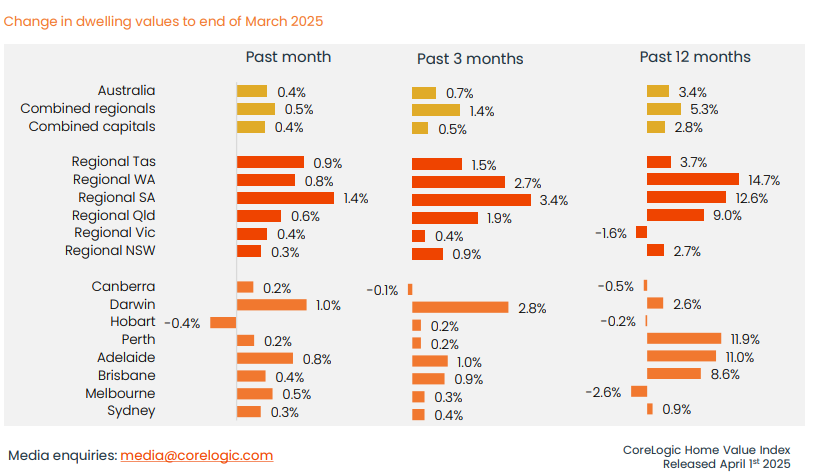
Source: CoreLogic
The consistent increase in the dwelling values across Brisbane, Adelaide and Perth showcase the growing appeal towards these regions. On the other hand, Melbourne has seen a slow recovery but its affordability factor when compared to its top-tier infrastructure and migration patterns in the region will see a huge rise over the coming years.
Regional vs. Capital Cities
Regionals have continued to outperform the capital regions, with the combined regional index standing at 0.5% and the combined capital index standing at 0.4% gain.But the gap between the two is narrowing and capitals regaining their momentum. The affordability of regional markets remains attractive, but as migration patterns normalize post-pandemic, major cities will see stronger price appreciation.
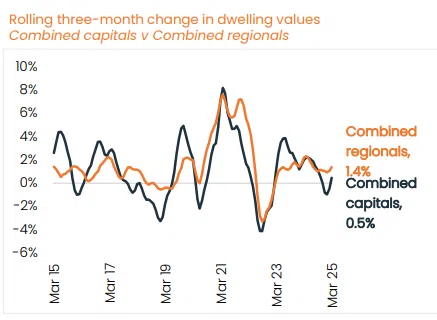
Source: CoreLogic
Stronger Rental Yields for Investors
- National rent values hit record highs, rising 0.6% in March. One of the key contributors to this has been the migration trends. As more and more people move to Australia, the demand and supply of properties is at an impasse causing increases in rent and dwelling values.
- Increase in rental yields: Gross rental yields of combined capitals now stands at 3.53%, the highest level since 2019, making rental properties increasingly attractive for investors.
- Slower rental growth: The pace of the rental growth is slower compared to that of 2020-2021 which was 9.7%, with the current annual rental growth over the past 12 months standing at 3.8%
With the vacancy rates at historical lows, the property owners are garnering huge profits from their rental properties. With increasing rental yields, the current market is highly favorable for property investors.
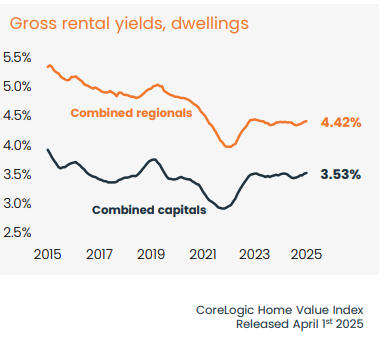
Source: CoreLogic
Factors Influencing Market Growth
Several economic and policy shifts are shaping property trends and market sentiment:
- Easing Monetary Policy: Improved buyer sentiment following the February cash rate cut has likely driven the turnaround in values, along with a slight improvement in borrowing capacity and mortgage serviceability.
- Cost of Living & Income Growth: Higher disposable incomes may strengthen buyer confidence, particularly in lower-priced markets. As the purchasing power increases the ability towards property purchase is greater.
- Market Sentiment Shifts: Renewed interest from investors and first-home buyers is influencing demand, especially in cities experiencing strong growth.
Read More: How Gross Rental Yields of 5% Can Help First Time Property Investors Build Wealth in Australia 2025
Possible Challenges in the australian property market ahead
While the market outlook remains positive, several challenges could moderate future price increases:
- Affordability Concerns: With property prices reverting, one key issue that is still in play is affordability. With increasing dwelling values which can further lead to higher mortgage repayments and borrowing costs. In turn, making home ownership even harder. Government initiatives and first-home buyer programs do reduce the pressure to an extent but the affordability issue is most likely to continue impacting the Australian property market especially the capital regions.
- Slower Population Growth: Population growth has always been a crucial determinant of housing demand and hence, the home values. However, with the migration rates stabilizing post-pandemic and economic uncertainties influencing relocation decisions, demand for housing may not surge at the same pace as it did in the past few years. This would impact the rental markets and slow down the rapid price appreciation seen in some capital regions.
- Cautious Credit Policies: The lending environment remains tight, with banks maintaining strict lending criteria. Even with the unchanged interest rate or possible cut later in the year, regulatory measures will While lower interest rates may provide some relief, regulatory measures to prevent excessive borrowing could limit purchasing power, especially for investors. The Australian Prudential Regulation Authority (APRA) continues to monitor lending standards, which could influence future borrowing capacity and property demand.

Why This Matters for Buyers & Investors
For purchasers, the existing market situation suggests a chance to act before real estate prices may rise more. The increase in home prices indicates a return of confidence, and as interest rates are likely to decrease further, the expense of borrowing may become easier to handle.
First-time homebuyers ought to think about entering the market now, as affordability might decline if prices keep increasing. Moreover, regional locations continue to provide appealing prices relative to major cities, rendering them a feasible choice for individuals seeking additional space and greater value.
For investors, the blend of unprecedented increase in rental yields offers a positive motive for investing in real estate. Due to the rental demand exceeding the supply, especially in capital regions cities, investors can expect further rental increase and reduced vacancy rates. Investors that are aiming to expand their property portfolio should consider high-growth suburbs and other locations that are expected to undergo infrastructural developments. In the end, comprehending these trends can help both purchasers and investors in taking advantage of the current market circumstances.

Reasons Why the Cash Rate Was Unchanged
- Underlying Inflation:
- Inflation has significantly declined from its peak in 2022.
- Higher interest rates have helped bring supply and demand closer to balance.=
- The Board wants to ensure inflation continues to move towards the target range sustainably.
- Global political and economic environment:
- Monetary policy needs to remain adaptable to international developments.
- Global uncertainties, such as U.S. tariffs and geopolitical risks, could impact inflation and economic growth.
- Uncertain Economic impact:
- Private domestic demand is showing signs of recovery, and real household incomes are improving.
- Some businesses are struggling to pass on cost increases due to weak demand.
- The labour market remains tight, but productivity growth is weak, leading to high unit labour costs.
- Previous rate-cuts effects
- The impact of previous rate hikes is still unfolding, making it difficult to assess future inflation and economic activity.
- The Board is monitoring how businesses adjust pricing and wages amid weak productivity. (Source: RBA)

The Australian real estate market is at a noteworthy point, as home prices start to rebound and rental returns hit their peak in years. Even though low affordability is still a problem, the predicted reduction in cash rates that is expected will help the investors by increasing their borrowing capacity. Even though the cash rate was unchanged after the meeting on 1st April, 2025. The rates will be under review again on May 20th, 2025. Whether you are a property buyer, investor or seller, staying on top of the news, and essential information needed to make the most of your property or possible investments at the right place, right time is crucial.
As the market evolves, Liviti is here to provide expert guidance and support. Whether you’re looking for the best investment opportunities or need assistance navigating market conditions, our team is ready to help. Schedule a call with Liviti today to start your property journey.

